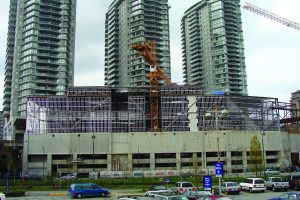Code Update: AISI Publishes Design Example to Illustrate New Method for Analytical Modeling of Cold-Formed Steel Structures

Engineers in the construction industry have traditionally relied on simplified approaches to building design based on standardized formulas and tabulated solutions. However, as software and tools evolve and become more accessible, the industry’s forward-thinking professionals are moving toward a more digital approach that leverages analytical models tailored to specific projects.
Analytical modeling is a relatively new approach for many engineers, but it’s becoming more common in the industry and university classrooms. Those who successfully implemented analytical modeling technology found it has the potential to improve productivity and efficiency in the design phase as well as reduce overall costs and improve the quality of structural designs.
New Code and Report
The American Iron and Steel Institute (AISI) provides methods for implementing this new technology in AISI S100-16, North American Specification for the Design of Cold-Formed Steel Structural Members, 2016 Edition. AISI S100-16 contains new provisions for analytical modeling of curtain wall systems and other cold-formed steel framing applications such as roof and wall systems that utilize purlins and girts.
For engineers interested in applying these new provisions, AISI recently published a research report titled “RP18-2: Design Example for Analytical Modeling of a Curtain Wall and Considering the Effects of Bridging (All-Steel Design Approach),” which provides an example of analytical modeling implemented in a practical design scenario.
RP18-2 focuses on analytical modeling of a cold-formed steel curtain wall for exterior framing of a mid-rise building. The example considers the effects of bridging to help prevent bending and twisting among framing members, supports framing, and ensures additional capacity from each steel framing member. Although RP18-2 describes a specific, standalone application of analytical modeling, this method can be applied to any cold-formed steel framing system.

Bailey Metal Products
Free Resources
The example in RP18-2 utilizes two academic software packages that are available as free resources for engineers: MASTAN2, a structural analysis program; and CUFSM, a cold-formed steel member finite strip analysis program. The software and data from this example are available for free download at https://bit.ly/2VsgsKK.
RP18-2 is one of many published reports developed by AISI to support and advance the use of cold-formed steel framing in building design and construction. AISI standards, specifications and research reports, including RP18-2, are available for download free of charge at www.aisistandards.org as a service to the design and construction community. AISI also offers cold-formed steel design manuals for purchase at https://shop.steel.org/. For more information on the benefits of steel for building construction—such as cost efficiency, design flexibility, sustainability and resilience—visit www.buildusingsteel.org.
About Robert Wills
Robert J. Wills, P.E., is vice president, Construction Market Development, Steel Market Development Institute, a business unit of AISI; email: [email protected].


